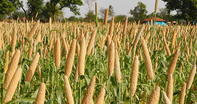Pearl millet, grown mostly on a subsistence level in South Africa, it is easier to grow and less prone to pests and diseases than sorghum, maize or other grains. The tiny seeds should be planted from October to November and if conditions are good, they will germinate within five days.

Pearl millet develops extremely deep roots that can reach into soil layers untapped by previous plants. Tests in the southeastern United States showed that pearl millet can use nutrients that accumulated below the root zones of previous farm crops.
Despite its drought resistance, pearl millet needs rainfall during the growing season but is sensitive to too much water during its flowering season. It does well on light soils, low pH soils of 4,5 - 5,5 and even soils high in aluminium, but cannot stand waterlogged clay soils. It responds well to fertilization and to crop rotation with a legume. Legumes such as cowpeas put nitrogen back into the soil.
Yields
The hundreds of flowers are packed on a cylindrical spike (rachis) that can range from 15 to 140 cm. About 40 days after fertilization, seeds should be ready to harvest. Under good conditions pearl millet hybrids can yield 3 - 4 ton/ha compared to 300 to 800 kg/ha when moisture and soil fertility become limiting factors.
Experiments in Florida, USA showed that closer row spacing 13 cm resulted in the highest yields - almost 5,5 ton/ha compared to 3,7 ton/ha at 76 cm spacing between rows. Normally pearl millet does not need insecticides but good weed control is required. Diseases in pearl millets are not widespread; the most important diseases are mildew, seed rot, rust and grain moulds.
Crop rotation with unrelated crops is probably the best practice for disease control. This prevents populations of pathogens from building up in the soil. Ripe millet is popular with birds; monitor the crop and harvest the seed plumes as soon as seeds are ripe.
Harvesting
Pearl millet heads are harvested 40 days after flowering, moisture content should be about 15%. Harvesting is done by hand (with a knife or sickle) or using a combine harvester. Harvesting for silage is best done mechanically when heads appear.
Harvesting equipment should be adjusted in order to thresh the small seeds completely, as poorly threshed millet has a lower feeding value. After harvesting, the heads are then dried on the ground or threshing floor.
Mould and germination of grain (sprouting) may occur if grains are not properly dried. Pearl millet can be difficult to process. The grains need to be dehulled (to remove the shell or husk) before grinding. Traditionally done by hand, this process produces low yields of flour, around 75%.
By Marinda Louw